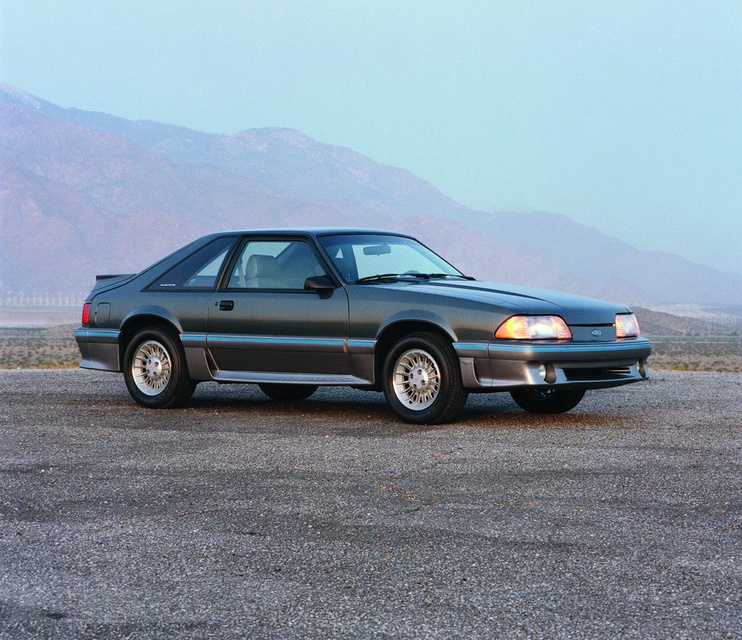
For decades the Fox-body Mustang
has served as a cornerstone of our
scene. Go to any motorsports
event and you’re just about guaranteed to
see these ubiquitous Fords. The general
public, from groders to street racers, has
been equally smitten.
Hate to break it to some of you, but
those Mustangs date back further than you
may think. When the …
Read the rest of the story
In reply to David S. Wallens:
My one, and only new car purchase... it was mid model year 1980. I came into a small amount of cash, and I decided to buy a new car....
Cars on the list came down to an overpriced leftover Mustang Indy Pace car, or a Capri with a few special ordered bits....
The Ford dealer wouldn't budge, so I ordered the Capri... Recaros, no A/C, TRX wheels/tires/suspension. Soon to be mods included running the Ferrari TRX tire (220, instead of 190), Koni Reds, Racer Walsh sway bar kits, and a Racer Walsh adjustable boost kit... 132 hp... HAHAHA, closer to 170 with water/alcohol injection 
Ford built the engines with undersized pistons (dumb) many of those early turbo engines failed... I had 2 fail under warranty. An engine fire was what eventually led to its sale. 

SEADave
HalfDork
10/29/15 5:16 p.m.
Funny, I just drove an 86 5.0 GT the other day. Fun car, way smaller than I remembered them. Unfortunately the one I was looking at was a little too rough even for me. The word is out and prices on these are going up quick.
For years we pretty much took these cars for granted. There will always be a never-ending supply, right? Now, yeah, it's getting hard to find a good one, especially a 5.0/5-speed.
I was gifted with three AX runs in a students 87 GT. It was a perfect survivor car, 45k miles and immaculate. On the stock size (and hardness) tires it was brilliant. Good power modulation. Great steering. You could hang it out and just hold it with power as long as you wanted. One of my favorite cars that I've been allowed to drive.
And no, it wasn't fast, but I didn't care in the least.
Great article! I own a mint, low km LX5.0L Notchback with windup windows and no AC. I love it, drive it on Sarurdays and autocross it on Sundays. Each year I own it I intend to upgrade it, but keep all the stock bits, just in case I do get a crazy offer for it. Last year I bought a used Corbeau race seat, rims and Dunlop Dirreza's. This year I want to do a 3:55 rear end, shocks/springs and rear disc brakes. Everything is just a click away on the computer, there's so much stuff out there for these cars. In my younger years I always had F body (Firebirds) and did my fair share of looking at these foxbody tail lights. I'm hoping I can keep it so my son and daughter can drive it, few years to go yet.
Stang
There is something just so right about a notchback 5.0 Mustang. Thanks for sharing.
I hate that I can't keep from doing this, and I know I'm over sensitive to the subject because I drive a Fairmont, but...
Why do people keep calling them Fox body (or Foxbody)? It's the Fox chassis people! Ford never used body codes (like a GM F-body or a Mopar B-body). The body parts of a Mustang do not fit on the other Fox chassis cars without modification. Other Fox chassis cars include the (Ford/Mercury) Fairmont/Zephyr ('78-'82), Thunderbird/Cougar ('80-'88) LTD/Marquis ('83-'86), and Granada ('81-'82), as well as the Lincoln Continental ('83-'86) and Mark VII ('83-'93). I realize that it just rolls off the tongue, but can't we please acknowledge the other equally good/bad Fox cars, and the adaptability of the platform?
All right. I'm done.
I love the fox platform. Ive owned 302 cars and a few i 2.3t swapped. The foxbody was a huge help in keeping the aftermarket alive, so many people stuff whatever motor they like in them for stock suspension drag racing. Its made cheap parts cars hard to find!
It was used in so many models that makes it fit all kinds of needs. Family outgrew the notchback so i found a wagon. It covers my wagon love and my favorite platform!
I agree, but I may be biased

If you spent your early driving years in the mid 70's to mid 80's like I did, the Mustang 5.0 GT was the first non-pathetic, attainable and practical thing to come to the market. I always wanted one, but I never got it (until last year).
I also love them for perpetuating an essentially endless supply of Ford 302 motors, (with decent EFI even!) to serve as donors for whatever craziness the collective spits out.
My first fast car was an 85 GT with the T-tops. So much fun. Too bad the car just fell apart faster than my college budget could stand to keep it toget her because I had so much fun with the car.
I worked for an attorney while in high school, and the head attorney's son drove a brand-new black/red 1987 Mustang GT. He could open and close the windows using his fob! My 16-year-old mind was blown.
My first car ever was a maroon over grey cloth 1987 Ford Mustang LX 5.0 notchback. The only mod I could afford was a pair of Flowmasters, which made it sound glorious. My parents foolishly bought the car for me new. I loved that car. Owned it for many years.
Fast forward to 2 months ago. I'm driving by a local, rinky-dink auto auction in town and spy a maroon over grey LX 5.0 notchback! Turns out it is a 1990 model, but looks pretty much identical. I worked with a friend to purchase it and am the proud new owner. Turns out it has aluminum heads, long tube headers, a clearly aftermarket clutch, gauges on the A-pillar and center console and a NOS set up! All for $2k before fees. It's like taking a time warp to almost 30 years ago!
Not sure if the car will become a $2016 Challenge car or get built into a road course carver, but I can't wait to start digging into it!
You should bring it to Gainesville for the $2016 Challenge. It's a great story.
Thanks for reminding me how much I want a teal 88-93 Mustang. Make mine a LX hatch on Ponys.
SilverFleet wrote:
Thanks for reminding me how much I want a teal 88-93 Mustang. Make mine a LX hatch on Ponys.
I could totally see you rocking that.
David S. Wallens wrote:
You should bring it to Gainesville for the $2016 Challenge. It's a great story.
I think that sounds like a great idea! To get me motivated, here is a video my buddy sent me after he picked it up. It must have a NASTY cam in it! 
https://www.youtube.com/embed/rYo6O8SVHSg

Opti
HalfDork
10/30/15 8:19 p.m.
My buddy was given, GIVEN, a teal 4cyl hatch, it had ponies on it. He never even picked it up, just put it up for sale on craiglist with a 5.0 and most of the components needed for a swap (which he also go free), got 2K for it.
It was probably the cleanest 4 cyl Ive ever seen. I wanted it SOOOO bad, and I dont even like fox bodies.
He did give me a 5.0 that I have no use for though.
In reply to dyintorace:
 oh my!! That sounds excellent!!
oh my!! That sounds excellent!!
This along with a copy of a Mustangs Unlimited catalog has me wanting a 4 eye notchback. Hopefully an '84 so I can have a birth year car. I haven't lusted for a fox mustang is over a decade.
I've owned two '89 hatchback LX 5.0s. Both moderately modified, both saw plenty of action on track, autocross, and drag racing. At one point, there were about 6 people in my group of friends who had modified Fox Mustangs. I still have a stock 5.0 motor in a storage bin in my garage. Eventually I got tired of trying to make that chassis handle well and moved on, but there's a part of me that really wants a black '86 GT with T-tops.
Tom_Spangler wrote:
I've owned two '89 hatchback LX 5.0s. Both moderately modified, both saw plenty of action on track, autocross, and drag racing. At one point, there were about 6 people in my group of friends who had modified Fox Mustangs. I still have a stock 5.0 motor in a storage bin in my garage. Eventually I got tired of trying to make that chassis handle well and moved on, but there's a part of me that really wants a black '86 GT with T-tops.
Some guy on my street, when I was a kid, had a Black '86 4 eye that I wanted bad. Loved the sound and that flat black stripe on the hood, magic.
David S. Wallens wrote:
SilverFleet wrote:
Thanks for reminding me how much I want a teal 88-93 Mustang. Make mine a LX hatch on Ponys.
I could totally see you rocking that.
What didn't help is when I went to buy some cheap drag slicks off a Mustang guy over the weekend... for reasons... and the guy had no less than 3 Fox Body Mustangs on premises. Two were notchbacks and the other was a Saleen convertible.
Anyone want to trade a Mustang for a Shelby CSX project? 
A notch, but you can barely tell in this view.













































